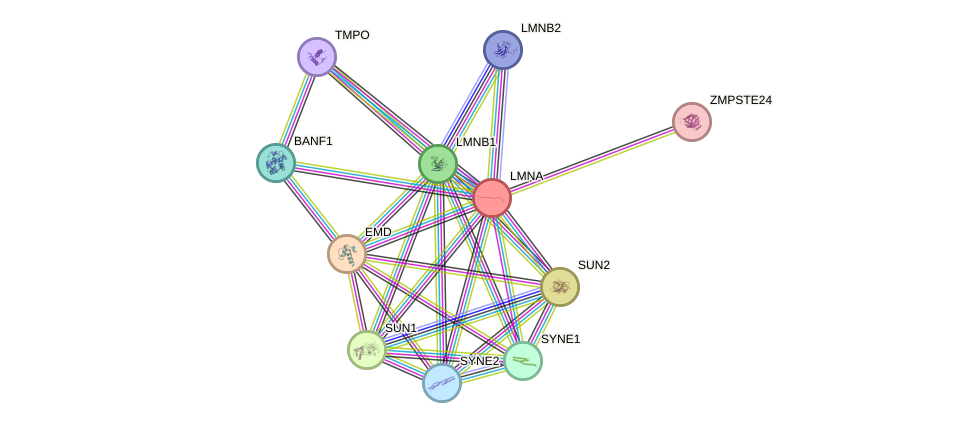GenAge entry for LMNA (Homo sapiens)
Entry selected based on evidence directly linking the gene product to ageing in humans
Gene name (HAGRID: 14)
- HGNC symbol
- LMNA
- Aliases
- HGPS; LMN1; CMD1A; LGMD1B; PRO1; LMNL1
- Common name
- lamin A/C
Potential relevance to the human ageing process
- Main reason for selection
- Entry selected based on evidence directly linking the gene product to ageing in humans
- Description
LMNA encodes both lamin A and C (lamin A/C), two components of the lamina, a layer of the inner nuclear membrane that may interact with chromatin [174]. Hutchinson-Gilford's progeroid syndrome, caused by a mutation in LMNA, is characterized by features resembling accelerated ageing [17]. Cells from Hutchinson-Gilford's progeroid syndrome patients are characterised by accumulation of abnormally shaped nuclei, accumulation of DNA damage and premature senescence [4328]. LMNA mutations (such as the G608G mutation) generate more accessible splicing donor sites and lead to the production of an alternatively spliced product of LMNA called progerin, normally found in ageing cells. Progerin binds directly to lamin A/C and induces profound nuclear aberrations in human cells.
Mice Lmna mutants containing the G690G mutation, which also display an increased ratio of progerin/Lamin A, have shorter lifespan compared to the wild-type ( ~40% in heterozygous mice, and ~83% in homozygous mice), while mice with Lmna LCS, a knock-in mutation responsible for specifically not-producing progerin, display an increased lifespan (~13% in heterozygous mice and ~10% in homozygous mice) [3548]. Lamin A/C are TP53BP1 binding proteins that promote TP53BP1 nuclear retention. Lmna knockout mouse embryonic fibroblasts are deficient in TP53BP1 and are unable to carry out the NHEJ DNA repair pathway [4328]. Sustained expression of progerin in mouse adipocytes results in senescence, DNA damage, inflammation, fibrosis and lipoatrophy. The findings suggested that adipose tissue is particularly sensitive to progerin expression [4509].
In flies LamC mutations are a model of human LMNA mutations. The flies demonstrate premature ageing in adult flight muscles and have decreased levels of specific mitochondrial protein transcripts and progressive mitochondrial degradation. Several transcripts required for mitochondrial integrity and function exit the nucleus via nuclear envelop budding. Abnormal lamina organisation due to LamC mutation may prevent the egress of these RNAs [4375]. Thus, absence of LMNA may accelerate ageing due to an impaired response to DNA damage and mitochondrial dysfunction.
Overall, LMNA is one of the most promising candidates for a gene related to human ageing.
Cytogenetic information
- Cytogenetic band
- 1q22
- Location
- 156,114,670 bp to 156,140,089 bp
- Orientation
- Plus strand
Protein information
- Gene Ontology
-
Process: GO:0007077; mitotic nuclear envelope disassembly
GO:0007084; mitotic nuclear envelope reassembly
GO:0030334; regulation of cell migration
GO:0030951; establishment or maintenance of microtubule cytoskeleton polarity
GO:0034504; protein localization to nucleus
GO:0035105; sterol regulatory element binding protein import into nucleus
GO:0036498; IRE1-mediated unfolded protein response
GO:0055015; ventricular cardiac muscle cell development
GO:0071456; cellular response to hypoxia
GO:0072201; negative regulation of mesenchymal cell proliferation
GO:0090201; negative regulation of release of cytochrome c from mitochondria
And 4 more GO terms Cellular component: GO:0005634; nucleus
GO:0005635; nuclear envelope
GO:0005638; lamin filament
GO:0005654; nucleoplasm
GO:0005737; cytoplasm
GO:0005829; cytosol
GO:0016607; nuclear speck
GO:0031012; extracellular matrix
GO:0031965; nuclear membrane
Show all GO termsFunction: GO:0005198; structural molecule activity
GO:0005515; protein binding
Protein interactions and network
- Protein-protein interacting partners in GenAge
- TP53, LMNA, MYC, EGF, PARP1, RPA1, VCP, TOP2A, UBE2I, PML, PRKCA, PRKDC, XRCC6, RB1, EMD, PCMT1, LMNB1, H2AFX, CTNNB1, SIRT6, CISD2, SIRT7
- STRING interaction network
Retrieve sequences for LMNA
Homologs in model organisms
- Caenorhabditis elegans
- lmn-1
- Danio rerio
- lmna
- Drosophila melanogaster
- LamC
- Mus musculus
- Lmna
- Rattus norvegicus
- Lmna
In other databases
- GenAge model organism genes
- GenAge microarray genes
- This gene is present as LMNA
- LongevityMap
- This gene is present as LMNA
- CellAge
- This gene is present as LMNA

